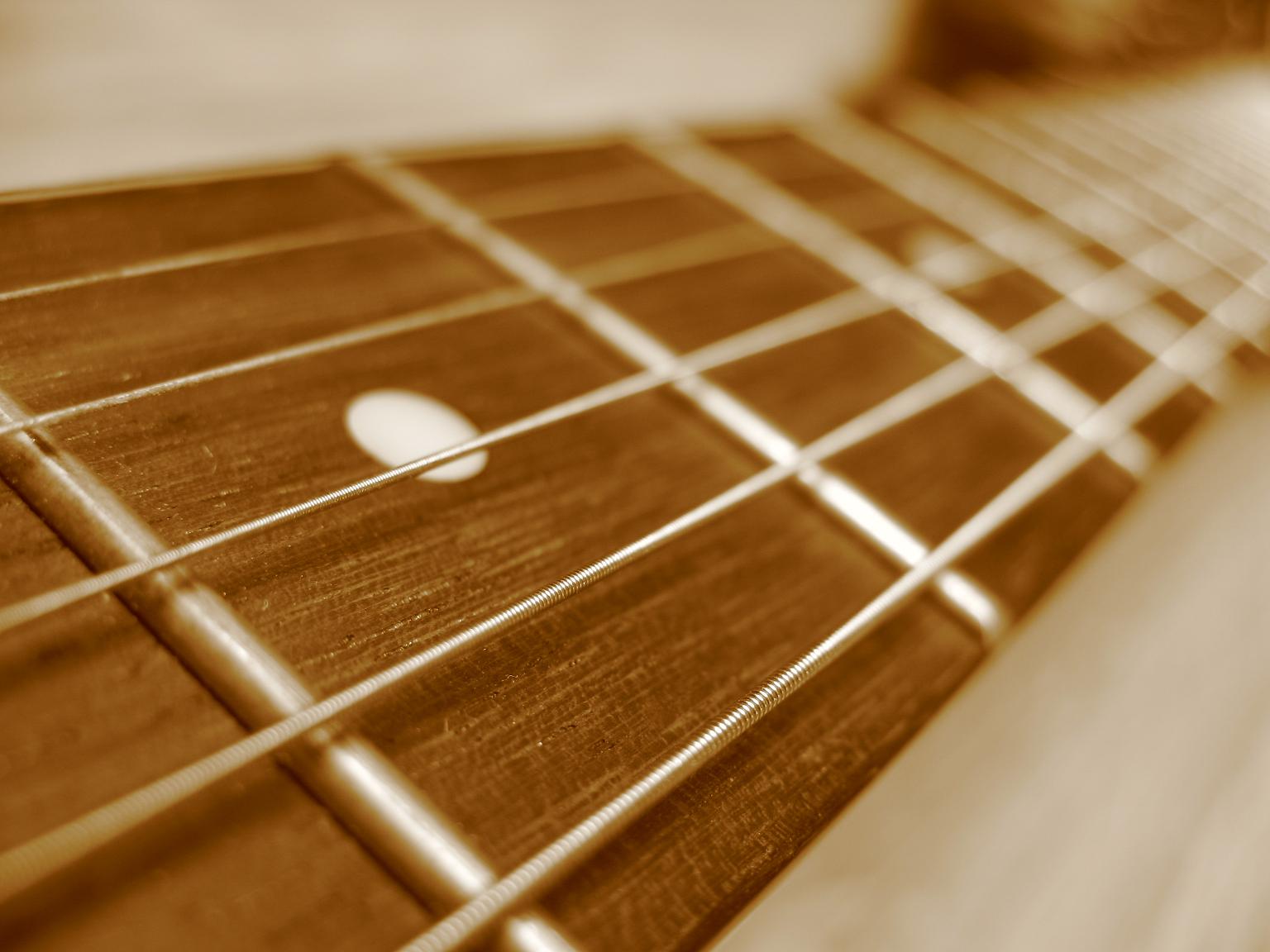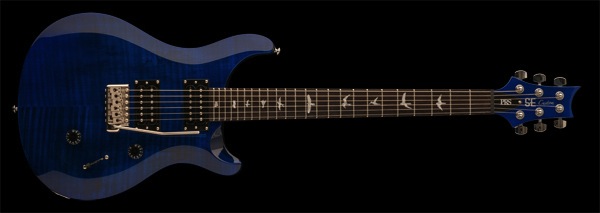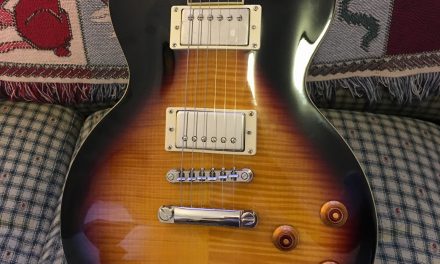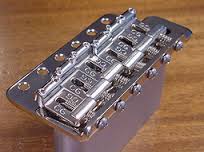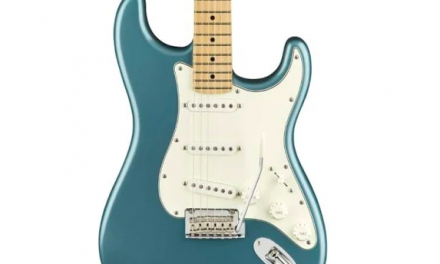Many guitar players spend their entire lives playing guitars without thinking at all about frets. But that’s folly. Frets can have a huge impact on your playing and thus your sound. This post will school you on everything you need to know about guitar frets.
There are three elements to address when discussing frets – composition, width, and height. Let’s bang out composition first.
Composition
Frets are usually made of a combination of nickel and silver, or nickel and steel. Sometimes fretwire makers will use copper in the mix, or stainless steel. Since most guitars have nickel/silver frets, it’s become somewhat of a standard. The harder a fret is, the less it will wear down over time, and the brighter it will sound.
If you think nothing matters, including the fret wire, go listen to a recording of a fretless guitar and then tell me it’s got the same zing as my Strat.
So yes, the harder a fret is, the brighter it will sound, in general, and the longer it will take to wear down. So some builders swear by stainless steel frets. PRS doesn’t do stainless steel on their guitars normally, but they do select an extremely hard nickel/silver fret that takes longer to wear down.
But the harder a fret is, the more difficult it is for builders to work with and repair technicians to fix. You might wonder why stainless steel frets aren’t routinely used on all guitars. Basically, it’s a pain in the ass for builders to work with because they take longer to use (which costs the builders money,) and some people think they sound too bright. They’re also 3 times harder on strings than regular frets, meaning the strings wear out three times quicker. The reason I don’t use them is I feel like my guitars are bright enough as it is, and my tools are better suited for standard fretwire.
Width
This one here is tricky. Height is easy, and we’ll talk about that in a minute. Why do acoustic guitars usually use thinner frets than electric guitars? Why do Gibson Les Pauls use thinner frets than Fender Strats? In general, wider frets take longer to wear down, and skinny frets provide better intonation. Does that mean that the intonation on a Les Paul is superior to a Strat? Not necessarily, but all things being equal, yes. But only by a very small amount that the average music fan won’t notice.
Think of it this way – when a fret is shaped (or crowned as we guitar repair folks say,) it’s not shaped like a semi-circle. More like the top of a school bus. The peak of the fret is called the landing zone, and that’s where the string makes contact with the fret. Depending on who crowned the fret, the landing zone might be very small or slightly larger. It might be perfectly flat or very slightly curved. And I’m talking about super small measurements here. But generalize it as the top of a school bus. So the wider the fret, the more flexible the landing zone can be. Sometimes you’ll find that wider frets have wider landing zones. If the landing zone is too wide, the fret will buzz, and intonation can be an issue.
Smaller width frets minimize the issue of having the landing zone too wide, and I think that’s where the “better intonation” thing comes from. Some players prefer smaller width frets because the landing zone on their guitar frets is super small. To me as a player, I definitely think it’s easier to play the really high frets if the landing zone is small on those frets. But it’s not night and day easier. And there’s no doubt that when it comes time to level and crown frets, wider frets last longer because there’s more material to work with.
Ultimately the marketplace has sort of standardized on a wider fret format – the Gibson Les Paul being a notable exception.
Height
Fret height is the most important of the three variables. Really high frets are around .053″ and really low frets could be .030″ or even lower. I shudder to think. There’s lots of talk about what the “best fret height” is, but it’s all crazy. Fret height is very personal to your playing. You might find, over time, that your taste in fret height changes. Certainly the style of music you play will usually have a big impact on your preference. But rather than say “This height is for metal, and this is for jazz,” let’s talk about the physics of how this works.
When you press a string down until it is firmly touching the fret, a few things are happening. Your fingertip is pushing down around the sides of the string. The string is pushing down on the landing zone of the nearest fret above your finger’s contact point on the neck. The contact point between the string and the fret creates an extremely small amount of wear on both metals – the string and the fretwire. Over time, this will cause dents in your frets and strings. Strings need to be replaced all the time, but for other reasons.
On a very short fret, your fingertip is touching the fretboard wood itself. This creates a very stable tone. Pushing down really, really hard won’t change anything, because your fingertip is already in contact with the wood. Conversely, if you push down a string near a very tall fret, the idea is for your finger to NOT touch the fretboard. You’re just applying enough pressure to get the note. If you apply too much pressure, the note will actually go sharp. Guitarists who push down very hard with their fretting hand usually don’t like tall frets, because they end up playing some notes too sharp. Some players use this as an advantage – you can achieve a type of vibrato simply by applying more or less pressure to the string.
So the taller the fret, the better technique you need with your fretting hand, just to stay in tune. With that in mind, why would anyone prefer tall frets? A few reasons. Short frets mean more pressure is required, so it is literally harder to play a guitar with short frets – you have to push down harder. Since you have to push down harder, it takes more effort to play quicker when you have to move your fingers around the fretboard with great speed. Some fans of short frets compensate for this by setting their action extremely low, which does help. But you still need to use more pressure, which can slow you down. This is why most speed players use tall frets – they want to be able to barely touch the string so they can get off it.
But some styles of music, like certain forms of jazz, require large slides on a fretboard. This is where you strike a string while holding down a note, and then slide your fretting finger up or down the fretboard while the string is still ringing. This is a joy on small frets, and a pain in the ass on tall frets. The frets feel like speed bumps, slowing you down. Similarly, if you play a style of music that features complicated chord fingerings and lots of chord changes, you might find that tall frets also feel like speed bumps. These are generalizations, of course, but they hold true very often.
Side Note – Vibrato is also an issue. Most players feel it is more difficult to do the type of fretting hand vibrato where you rotate your hand back and forth if your fingertip is pressed up against the fretboard. For some types of music (jazz,) that type of vibrato isn’t used much. For other types of music (blues,) it’s used constantly.
So short frets and tall frets, dependent on your playing style. OK, but… what if you play all kinds of different styles? And if you make guitars, what can you do to make your guitar appeal to both types of preferences? Well, short frets are often called “vintage” frets. And tall frets are often called “jumbo” frets. Most guitars these days come with a fret height in between the two – a “medium-jumbo” fret, if you will. Actually that’s exactly what they call it. So a typical Fender Strat, for example, comes with medium-jumbo frets. They’re tall enough to appeal to speed players but short enough to prevent the heavy handed from knocking their chords out of tune. Personally, this is my favorite fret size. I can play jumbo frets OK, and I have a couple of guitars with jumbo frets, but mostly I like medium-jumbo. And medium-jumbo has sort of become the standard fretwire.
That’s as much as most players need to know about frets. Why does it matter? Because when I bought my very first Fender Stratocaster, it had vintage frets on it. It sounded great, but it played so-so, and I never really understood why until I learned about frets. And then I’d wished I’d bought a guitar with taller frets. So my next Fender Strat had jumbo frets. And while I liked them, I grew to eventually dislike the speed bump effect. So I finally settled on medium-jumbo frets.

